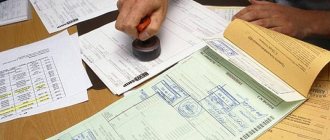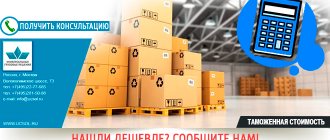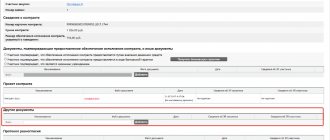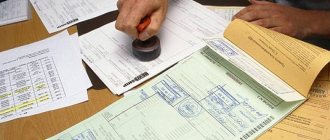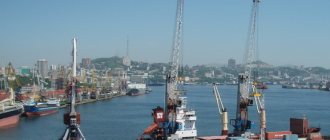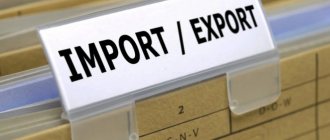Author of the article
Yuri Stanislavovich Burashnikov
Reading time: 7 minutes
AA
To move goods across the border, the customs authority must provide a cargo customs declaration. But it will not have legal force without another document - a declaration of customs value, which indicates the customs value of the cargo.
We will tell you what a declaration of customs value (DTV) is and the customs value of goods itself, how to calculate the customs value and who should do this. Let's look at the rules for filling out the DTS and the documents that need to be attached to it, as well as other nuances of completing the declaration of customs value.
What is a declaration of customs value?
Declaration of customs value – a document attached to the cargo customs declaration.
It indicates the customs value of the cargo, as well as the method for calculating it. A DTS is required to calculate the duties that will be levied on the cargo. For this reason, the cost obtained as a result of calculations must be supported by documents. If there are suspicions of unreliable calculations, customs officers may decide to refuse to accept the DTS. Having a problem? Call our customs specialist:
8-495-565-32-46
We calculate the customs value of goods
Customs value is the cost of cargo, calculated on the basis of international treaties of the states of the Customs Union.
The cost is calculated with the following objectives:
- taxation of cargo;
- implementation of economic policy for the import and export of free circulation cargo;
- obtaining data on foreign trade of a state that is a member of the Customs Union;
- control over the injection of duties into the country's treasury;
- calculation of the balance of payments and trade.
The customs value is calculated by the declarant or customs broker. The result of the calculations must be confirmed by the attached documents.
Control over customs value is carried out by customs officers. The documents attached to the calculations must contain all the information on the basis of which the calculations were made.
There are several methods for calculating the customs value of goods:
- Based on the price of transactions with cargo transported to the CU states or exported from the territory of the Customs Union.
- Based on the cost of similar cargo.
- Based on prices for homogeneous cargo.
- By subtracting the cost.
- By adding value.
- Backup method.
The most common is the first method.
The remaining five methods are used if the first is not suitable. The first method may not be suitable for performing calculations in the following cases :
- lack of all necessary documents;
- the buyer does not have the entire list of rights to the cargo;
- There is no fixed value of the cargo; its exact calculations are impossible at the time of calculating the customs value.
The customs value consists of the following details:
- the actual cost of the cargo indicated by the manufacturer;
- costs of transporting cargo to the border;
- loading and unloading work to the border;
- packaging of cargo, cost of packaging, cost of packaging work;
- insurance services;
- opening an export declaration;
- royalties and other possible payments;
- all costs before crossing the border.
The fact of these expenses will need to be confirmed by relevant documents.
Customs duties and fees are calculated based on the DTS.
III. PROCEDURE FOR DECLARING THE CUSTOMS VALUE OF GOODS
III. Rules for filling out DTS-2
23. The procedure for filling out the columns by the person making up the DTS-2:
Column 1.
The full name (for legal entities) or surname, first name, patronymic (for individuals) and address of the location of the foreign person who is a party to the foreign economic transaction are indicated:
for an organization - name and location (address);
for an individual entrepreneur - last name, first name, patronymic and his place of residence (short name of the country, administrative-territorial unit, locality, street, house and apartment number).
Column 2a.
Information about the person who is a party to the transaction in the country of import of goods (or the recipient of goods in a unilateral transaction), according to which goods are imported into the customs territory of the Union, is indicated:
for an organization - name, its legal form and location (short name of the country, administrative-territorial unit, locality, street, house and apartment number);
for an individual entrepreneur - last name, first name, patronymic and his place of residence (short name of the country, administrative-territorial unit, locality, street, house and apartment number).
In the upper right corner of the column it is indicated:
for the Republic of Armenia - taxpayer registration number (TIN);
for the Republic of Belarus - payer registration number (UNP);
for the Republic of Kazakhstan - an identification number (IN) for an organization (branch and representative office) and an individual entrepreneur operating as a joint venture, or an individual identification number (IIN) for an individual, including an individual entrepreneur operating as a personal entrepreneurship;
for the Kyrgyz Republic - a taxpayer identification number (TIN) assigned to the recipient in accordance with the legislation of the Kyrgyz Republic, if the recipient is a legal entity or an individual registered as an individual entrepreneur in accordance with the legislation of the Kyrgyz Republic, or a personal identification number (PIN), if the recipient is an individual carrying out commercial activities on the territory of the Kyrgyz Republic and not registered as an individual entrepreneur;
for the Russian Federation - taxpayer identification number (TIN) and, through the separator “/”, the reason for registration code (KPP).
At the bottom of the column it is indicated:
for the Republic of Kazakhstan - customs identification number (CIN) of the buyer in accordance with the Classifier for the formation of customs identification number;
for the Kyrgyz Republic - code of the All-Republican Classifier of Enterprises and Organizations (OKPO) for legal entities and individual entrepreneurs;
for the Russian Federation - the main state registration number (OGRN) or the main state registration number of the record of state registration of an individual entrepreneur (OGRNIP).
Column 2b.
The column indicates information about the person who filled out the DTS-2:
for an organization - name, its legal form and location (short name of the country, administrative-territorial unit, locality, street, house and apartment number);
for an individual entrepreneur - last name, first name, patronymic and his place of residence (short name of the country, administrative-territorial unit, locality, street, house and apartment number).
In the upper right corner of the column it is indicated:
for the Republic of Armenia - taxpayer registration number (TIN);
for the Republic of Belarus - payer registration number (UNP);
for the Republic of Kazakhstan - an identification number (IN) for an organization (branch and representative office) and an individual entrepreneur operating as a joint venture, or an individual identification number (IIN) for an individual, including an individual entrepreneur operating as a personal entrepreneurship;
for the Kyrgyz Republic - a taxpayer identification number (TIN) assigned to the recipient in accordance with the legislation of the Kyrgyz Republic, if the recipient is a legal entity or an individual registered as an individual entrepreneur in accordance with the legislation of the Kyrgyz Republic, or a personal identification number (PIN), if the recipient is an individual carrying out commercial activities on the territory of the Kyrgyz Republic and not registered as an individual entrepreneur;
for the Russian Federation - taxpayer identification number (TIN) and, through the separator “/”, the reason for registration code (KPP).
At the bottom of the column it is indicated:
for the Republic of Kazakhstan - the customs identification number (CIN) of the person filling it out, in accordance with the Classifier for the formation of a customs identification number;
for the Kyrgyz Republic - code of the All-Republican Classifier of Enterprises and Organizations (OKPO) for legal entities and individual entrepreneurs;
for the Russian Federation - the main state registration number (OGRN) or the main state registration number of the record of state registration of an individual entrepreneur (OGRNIP).
Column 3.
The name of the delivery conditions (in Latin characters) is indicated in accordance with the Classifier of Delivery Conditions and the name of the geographical location, based on the information specified in the commercial documents accompanying the transaction, or, in the absence of such information, based on the actual circumstances of the organization of the transaction.
Column 4.
The number and date of the document that is the basis for the delivery of the declared goods are indicated (for example, the number and date of the agreement on the free supply of goods).
Column 5.
The details (number and date) of documents with decisions previously taken by customs authorities on inspections carried out in relation to previous deliveries of goods under this agreement, or decisions of judicial authorities in relation to such goods, are indicated. Documents from column 8 are not indicated.
Column 6.
O the method that is used to determine the customs value of the declared goods.
When determining the customs value using method 6 based on method 1, a mark is made only in field (e).
When determining the customs value according to method 6 based on methods 2 - 5, a mark is simultaneously made in field (d) and in the field corresponding to one of methods 2 - 5.
If to determine the customs value of goods indicated under different numbers in columns DTS-2 “Product N”, different methods for determining the customs value are used, a mark is made in field (g).
Column 7.
A brief justification of the reasons why all methods preceding the method specified in column 6 are not applicable, while for method 1 it is necessary to indicate the specific provisions of international treaties and acts constituting the law of the Union, according to which its application is impossible; for other methods, the lack of relevant documents and information (with their specification) is indicated as the basis for the impossibility of their use.
Column 8.
The names and details of the main documents submitted in support of the declared information are indicated based on the applied method for determining the customs value.
When determining the customs value using methods 2 and 3, the details of the documents used are indicated, on the basis of which the customs value of identical or similar goods was accepted by the customs authority using method 1: number and date of the contract, invoices, registration number of the declaration of goods and declaration of customs value, compiled according to the DTS-1 form, if it was filled out.
When determining the customs value of goods according to method 4, the details of the documents used containing information about the price of previously imported identical or similar goods or goods being valued, at which the largest total number of goods are sold in the single customs territory of the Union, are indicated: invoices, contracts or other documents confirming unit price.
When determining the customs value of goods according to method 5, documents are indicated on the basis of which the estimated value of goods is accepted, based on the fact that such documents comply with generally accepted accounting principles applied in the country where the goods were produced.
When determining the customs value of goods using method 6, the details of the documents are indicated, which are used in accordance with the requirements of the Agreement on the flexible use of methods 1 - 5 as the basis for determining the customs value of the goods being valued using this method.
Column 9.
The number of additional sheets for DTS-2 is indicated (the number of sheets must correspond to the number of the last sheet, reduced by 2).
Box 10.
Filled out in the manner prescribed for filling out column 10b of DTS-1.
Methods 2, 3 and method 6 based on them
24. Sheet of the second form of DTS-2 for methods 2, 3, 6.
Column "Product N".
The product number from the corresponding column of the goods declaration is indicated.
When declaring goods of different names contained in one consignment, indicating one classification code according to the Commodity Nomenclature of Foreign Economic Activity of the EAEU, when it is necessary to indicate information on each or some goods from the list, the corresponding serial number of the goods on the list is indicated.
Column “EAEU Commodity Nomenclature for Foreign Economic Activity Code”.
The product code according to the Commodity Nomenclature of Foreign Economic Activity of the EAEU is indicated.
The cost indicators given in columns 11 to 18a are indicated in the currency of the Union member state.
Box 11.
The value of a transaction with identical or similar goods sold for import into the customs territory of the Union and imported into the customs territory of the Union in the same or corresponding period of time as the goods being valued is indicated, that is, the customs value of identical or similar goods determined by the declarant in accordance with Article 4 of the Agreement and accepted by the customs authority in the prescribed manner (column 25a of DTS-1).
Section B “Transaction value adjustments (+/-)”.
This section provides appropriate adjustments to the value of a transaction with identical or similar goods indicated in column 11 (to the customs value of identical or similar goods specified in column 25a of the corresponding DTS-1), ensuring that the conditions for the import of identical (homogeneous) goods are comparable with conditions for the import of the goods being valued.
Adjustments can be either with a “+” sign if they increase the cost of a transaction with identical or similar goods, or with a “-” sign if they reduce the cost of a transaction with identical or similar goods.
Adjustment of the value of a transaction with identical or similar goods is carried out on the basis of information confirming the validity and accuracy of such adjustments and meeting the requirements of international treaties and acts constituting the law of the Union.
Box 12a.
Indicate the amount by which the cost of a transaction with identical or similar goods given in column 11 should be reduced in connection with a change in the price per unit of goods (this refers to cases where, in accordance with the contract (agreement), the price per unit of goods depends on the number of goods sold units of goods, and the valued and identical (homogeneous) goods are sold in quantities corresponding to different price levels per unit of goods).
The column is not filled in if column 11 indicates the value of a transaction with identical or similar goods sold in essentially the same quantity as the goods being valued (that is, at the same price per unit of goods), or there is no documentary evidence that the price per unit of goods depends on the number of units sold of this product.
Box 12b.
The amount by which the value of a transaction with identical or similar goods given in column 11 should be reduced, is indicated, as if the identical or similar goods were sold at the same commercial level as the goods being valued.
The column is not filled in if column 11 indicates the value of a transaction with identical or similar goods sold at the same commercial level (wholesale, retail, etc.) as the goods being valued.
Count 12th century.
Indicated:
— place (geographical point) of arrival of the goods being valued into the customs territory of the Union;
- the difference in the costs of transportation (transportation) to the place of arrival in the customs territory of the Union of identical or similar goods and the goods being valued.
The column is filled in if the goods being valued, unlike identical (homogeneous) goods, are transported along a different route and (or) a different type of transport.
Count 12g.
The difference in the costs of loading, unloading or reloading and other operations associated with the transportation (transportation) of identical or similar goods to the place of arrival in the customs territory of the Union, and similar costs in relation to the goods being valued, is indicated.
Column 12d.
The difference in insurance costs for the goods being valued and identical and similar goods in connection with the operations specified in columns 12c and 12d is indicated.
Columns 12d and 12d are filled in if the corresponding expenses in relation to the goods being valued differ significantly from such expenses included in the cost of the transaction with identical or similar goods indicated in column 11.
Box 13.
The sum of the values given in columns 12a to 12e is indicated.
Box 14a.
Indicate the amount by which the cost of a transaction with identical or similar goods given in column 11 should be increased in connection with a change in the price per unit of goods (this refers to cases where, in accordance with the contract (agreement), the price per unit of goods depends on the number of units sold goods, and the valued and identical (homogeneous) goods are sold in quantities corresponding to different price levels per unit of goods).
The column is not filled in if column 11 indicates the value of a transaction with identical or similar goods sold in essentially the same quantity as the goods being valued (that is, at the same price per unit of goods), or there is no documentary evidence that the price per unit of goods depends on the number of units sold of this product.
Box 14b.
The amount by which the value of a transaction with identical or similar goods given in column 11 should be increased, as if the identical or similar goods were sold at the same commercial level as the goods being valued.
The column is not filled in if column 11 indicates the value of a transaction with identical (homogeneous) goods sold at the same commercial level (wholesale, retail, etc.) as the goods being valued.
Count 14th century.
Indicated:
— place (geographical point) of arrival of the goods being valued into the customs territory of the Union;
- the difference in the costs of transportation (transportation) to the place of arrival in the customs territory of the Union of identical or similar goods and the goods being valued.
The column is filled in if the goods being valued, unlike identical or similar goods, are transported along a different route and (or) by a different type of transport.
Count 14g.
The difference in the costs of loading, unloading or reloading and other operations associated with the transportation (transportation) of identical or similar goods to the place of arrival in the customs territory of the Union, and similar costs in relation to the goods being valued, is indicated.
Column 14d.
The difference in insurance costs for the goods being valued and identical or similar goods in connection with the operations specified in columns 12c and 12d is indicated.
Columns 14d and 14d are filled in if the corresponding expenses in relation to the goods being valued differ significantly from such expenses included in the cost of a transaction with identical or similar goods indicated in column 11.
Box 15.
The sum of the values given in columns 14a to 14d is indicated.
Box 16.
The value of the transaction with identical or similar goods is indicated, reduced by the amount indicated in column 13, and increased by the amount indicated in column 15.
If identical or similar goods are sold at the same commercial level (wholesale, retail or otherwise) and in substantially the same quantity as the goods being valued, and there is no need to adjust the transaction value of them to account for a significant difference in the costs specified in the subparagraphs 4 - 6 of paragraph 1 of Article 5 of the Agreement, in relation to the valued and identical (homogeneous) goods, due to differences in the distances over which they are transported (transported) and modes of transport, then in column 16 the value of the transaction indicated in column 11 is given.
Column 17.
The quantity of goods is indicated in the appropriate units of measurement (kilograms, pieces, etc.) with such units of measurement indicated immediately after the given value.
The column is not filled in if the number of evaluated and identical or homogeneous goods is the same. This column does not take into account the adjustment specified in columns 12a, 14a.
Box 17a.
The number of identical or similar goods, the transaction value of which is indicated in column 11, is indicated.
Box 17b.
The number of goods being valued (declared) is indicated.
Box 18a.
The customs value of the goods being valued is indicated, calculated by multiplying the value indicated in column 16 by the ratio of the value given in column 17b to the value given in column 17a.
If column 17 was not filled in, the information in column 16 is used.
Box 18b.
The customs value of the goods being valued is indicated in column 18a, recalculated into US dollars at the appropriate exchange rate on the date of registration of the declaration for goods by the customs authority.
Column "Additional data".
If necessary, any additional data (calculations) related to the information provided in DTS-2 are indicated.
Column "Signature, seal".
The sheet is signed by the declarant or a customs representative, if the declaration is made by a customs representative, and certified in the prescribed manner.
Method 4 and method 6 based on it
25. Sheet of the second form DTS-2 for methods 4, 6.
Column "Product N".
The product number from the corresponding column of the goods declaration is indicated.
When declaring goods of different names contained in one consignment, indicating one classification code according to the Commodity Nomenclature of Foreign Economic Activity of the EAEU, when it is necessary to indicate information on each or some goods from the list, the corresponding serial number of the goods on the list is indicated.
Column “EAEU Commodity Nomenclature for Foreign Economic Activity Code”.
The product code according to the Commodity Nomenclature of Foreign Economic Activity of the EAEU is indicated.
The cost indicators given in columns 11 to 18a are indicated in the currency of the Union member state.
Box 11.
The unit price of the valued, identical or homogeneous goods is indicated at which their largest aggregate quantity in an unchanged condition is sold to persons who are not related persons with persons carrying out sales in the customs territory of the Union.
In the absence of cases of sale of the valued, identical or homogeneous goods in the same condition in which they were imported into the customs territory of the Union, in this column the declarant shall indicate the price of a unit of goods at which the largest aggregate quantity of the valued goods is sold after their processing (processing) to persons who are not related to persons carrying out sales in the customs territory of the Union.
Section B “Deductions of amounts included in section A (per unit of goods).”
The amounts subject to deduction in accordance with paragraph 2 of Article 8 of the Agreement, calculated per unit of goods and included in the amount given in section A, are indicated.
Column 12.
The amount of remuneration to the intermediary (agent), usually paid or subject to payment, or price premiums usually made to make a profit and cover commercial and administrative expenses in the amounts usually occurring in connection with the sale of goods of the same class or type in the customs territory of the Union is indicated .
Box 13.
The amount of usual expenses for transportation (transportation) and insurance carried out in the customs territory of the Union and other expenses associated with such operations are indicated.
Box 14.
The amount of customs duties, taxes, fees, as well as taxes established in accordance with the legislation of the Union member states that are payable in connection with the import of goods into the customs territory of the Union or their sale on this territory, including taxes and fees of the subjects of the Union member states is indicated and local taxes and fees.
Box 15.
The value added as a result of processing (processing) of goods in a member state of the Union is indicated (all costs associated with carrying out such operations, including the cost of components that were part of the goods, the cost of materials used during processing, etc.) , in the case where the declarant in column 11 shows the price of a unit of goods after their processing.
Box 16.
The sum of the values given in columns 12 - 15 is indicated.
Column 17.
The number of goods being valued (declared) is indicated.
Box 18a.
The customs value of the goods being valued is indicated, calculated by subtracting from the value given in column 11 the value specified in column 16, and multiplying the resulting value by the value specified in column 17.
Box 18b.
The customs value of the goods being valued (declared) given in column 18a is indicated, recalculated into US dollars at the appropriate exchange rate on the date of registration of the declaration for goods by the customs authority.
Column "Additional data".
If necessary, any additional data (calculations) related to the information provided in DTS-2 are indicated.
Column "Signature, seal".
The sheet is signed by the declarant or a customs representative, if the declaration is made by a customs representative, and certified in the prescribed manner.
Method 5 and method 6 based on it
26. Sheet of the second form DTS-2 for methods 5, 6.
Column "Product N".
The product number from the corresponding column of the goods declaration is indicated.
When declaring goods of different names contained in one consignment, indicating one classification code according to the Commodity Nomenclature of Foreign Economic Activity of the EAEU, when it is necessary to indicate information on each or some goods from the list, the corresponding serial number of the goods on the list is indicated.
Column “EAEU Commodity Nomenclature for Foreign Economic Activity Code”.
The product code according to the Commodity Nomenclature of Foreign Economic Activity of the EAEU is indicated.
Box 11.
The total amount of expenses of the manufacturer (seller) of the valued goods for the manufacture and (or) acquisition of materials and production costs, as well as for other operations related to the production of the valued (imported) goods, including costs for containers and packaging (column 11a) is indicated ), as well as the cost of design, development, engineering, design work, design, decoration, drawings and sketches paid by the manufacturer, produced in the customs territory of the Union (column 11b).
All information necessary to calculate the customs value of goods according to method 5 can be used only if they are determined on the basis of reliable, quantifiable and documented information. The information required to calculate the customs value of goods must be based on the commercial accounts of the manufacturer, provided that such accounts comply with generally accepted accounting principles applicable in the country where the goods are produced. As documentary evidence of such information, the declarant has the right to submit documents (conclusions) of independent organizations (industry associations, unions of goods manufacturers, chambers of commerce and industry, etc.) confirming the compliance of the documents submitted by the declarant with the legislation of the country of production of the goods, including the compliance of the specified information on the level of production costs, as well as the level of profit and general (commercial and administrative) expenses typical for the sale of goods of the same class or type as the goods being valued for export to the customs territory of the Union.
Column 12.
The appropriately distributed cost of goods and services provided directly or indirectly by the buyer (recipient) of the goods being valued to their manufacturer free of charge or at a reduced price for use in connection with production and export to the customs territory of the Union and not included in the costs specified in column 11 is indicated.
Box 12a.
The appropriately distributed cost of raw materials, materials, parts, semi-finished products and other similar items that make up the valued (declared) goods is indicated.
Box 12b.
The appropriately distributed amount of expenses for the acquisition of tools, stamps, molds and other similar items used in the production of imported goods is indicated, if these items are purchased from a person who is not a related person with the buyer (recipient), or the costs of their production, if the items are produced the buyer or a person who is related to the buyer (recipient) of the goods being valued.
The distribution of the value of the specified items used in the production of the goods being valued can be carried out by attributing this entire value to the customs value of the first batch of goods or to the customs value of another quantity of goods determined by the declarant, which cannot be less than the number of declared goods. Such allocation must be made in a manner appropriate to the particular circumstances, depending on the documents available to the declarant and in accordance with generally accepted accounting principles.
If these items were previously used, the original purchase or production price is subject to reduction to account for wear and tear.
Count 12th century.
The appropriately distributed cost of materials consumed in the production of imported goods (for example, consumed fuels and lubricants) is indicated.
Count 12g.
The appropriately distributed cost of design, development, engineering, design work, decoration, design, sketches and drawings performed outside the customs territory of the Union in relation to the goods being valued is indicated.
In relation to such goods and services (work), if they were purchased or leased, the costs of their acquisition or lease are taken into account.
In relation to goods presented by the buyer (recipient) that were purchased or rented by the buyer, additions are made in relation to the costs of purchasing or renting such goods and services. If the buyer (recipient) presents goods and services that are in public ownership, that is, state or municipal property, additional charges are made regarding the cost (costs) of obtaining copies from them.
Box 13.
The amount of profit and general (commercial and administrative) expenses is indicated, equivalent to the amount that is usually taken into account when selling goods of the same class or type as the goods being valued (imported), which are produced in the country of export for export to the customs territory of the Union.
Box 14.
The amount of costs for transportation (transportation) of the goods being assessed to the airport, port or other place of their arrival in the customs territory of the Union is indicated. If transportation (transportation) is carried out by different modes of transport, then the total costs of transportation (transportation) by all modes of transport are taken into account.
If transportation (transportation) was carried out free of charge or using the buyer’s (recipient’s) own vehicles, this column provides the value calculated on the basis of transportation tariffs by the relevant mode of transport in force during the period of transportation (transportation) of goods or in the corresponding period of time (seasonality of transportation ).
If the declarant does not have data on tariffs for transportation by this type of transport, then to calculate transport costs, accounting data for calculating transport costs including all necessary items or cost elements is used.
If DTS-2 is filled out for goods of several types, then the costs of transportation (transportation) of goods are distributed between goods of different types in proportion to their gross weight.
Column 14 indicates the place (geographical point) of arrival of goods into the customs territory of the Union or the destination of goods in the customs territory of the Union, costs up to which must be included in the customs value.
If the costs of transportation (transportation) from the place of arrival in the customs territory of the Union to the destination in the customs territory of the Union cannot be documented, then column 14 indicates the destination in the customs territory of the Union. If the division of transportation costs (transportation) from the place of departure to the place of arrival in the customs territory of the Union and from the place of arrival to the place of destination can be documented, then column 14 indicates the place of arrival of the goods in the customs territory of the Union.
Column 14 also indicates the costs of customs declaration of goods when exported from the country of export (if any), as well as the freight forwarder’s remuneration.
Box 15.
The costs of loading, unloading or transhipment of the goods being valued and carrying out other operations related to their transportation (transportation) carried out to the place of arrival of these goods in the customs territory of the Union are indicated.
If DTS-2 is filled out for goods of several types, such expenses are distributed among the corresponding goods in proportion to their gross weight.
Box 16.
Insurance costs in connection with the operations specified in subparagraphs 4 and 5 of paragraph 1 of Article 5 of the Agreement are indicated.
If DTS-2 is filled out for goods of several types, then insurance costs are distributed among the corresponding goods in proportion to their value.
Box 17a.
The customs value of the goods being valued is indicated in the currency of the Union member state, calculated as the sum of the values given in columns 11 to 16.
Box 17b.
The customs value given in column 17a is indicated, converted into US dollars at the appropriate exchange rate on the date of registration of the declaration for goods by the customs authority.
Column "Additional data".
If necessary, any additional data related to the information provided in DTS-2 shall be indicated.
Column "Signature, seal".
The sheet is signed by the declarant or a customs representative, if the customs declaration is made by a customs representative, and certified in the prescribed manner.
Method 6 based on Method 1
27. Sheet of the second form DTS-2 for method 6.
Column "Product N".
The product number from the corresponding column of the goods declaration is indicated.
When declaring goods of different names contained in one consignment, indicating one classification code according to the Commodity Nomenclature of Foreign Economic Activity of the EAEU, when it is necessary to indicate information on each or some goods from the list, the corresponding serial number of the goods on the list is indicated.
Column “EAEU Commodity Nomenclature for Foreign Economic Activity Code”.
The product code according to the Commodity Nomenclature of Foreign Economic Activity of the EAEU is indicated.
All information provided in columns 11 - 25 must be based on reliable, quantifiable and documented information.
Columns 11 - 25 are filled in in relation to the order of filling out columns 11 - 25 of DTS-1, taking into account the following features.
In the absence of a purchase and sale transaction or the unacceptability of the price actually paid or subject to payment, based on the requirements of Article 4 of the Agreement, to determine the customs value of the goods being valued, the value of these goods may be indicated, equivalent (close) to the price actually paid or subject to payment, and confirmed by the relevant documents (for example, the book value of the goods being valued when they are registered for accounting and taxation in accordance with the legislation of a member state of the Union).
If the reason for the impossibility of using method 1 to determine the customs value of the goods being valued is the lack of necessary documentary evidence of additional charges, then column 11a indicates the price actually paid or payable for the goods, confirmed in accordance with established requirements when using method 1.
Section B “Additional charges: expenses in national currency that are not included in A” indicates information about additional charges to the basis for calculating customs value based on documented calculation data (for example, based on accounting data for a fairly representative past period - quarter, year; planned indicators for the corresponding future period of time - indicators of business plans, etc., approved by the organization; price lists and catalogues; tariffs for transportation, loading and unloading operations, etc.).
Column "Additional data".
If necessary, indicate any additional data related to the information provided in the declaration.
Column "Signature, seal".
The sheet is signed by the declarant or a customs representative, if the customs declaration is made by a customs representative, and certified in the prescribed manner.
Filling out the DTS
When importing goods into the territory of the Customs Union, a declaration of customs value of the form DTS-1, DTS-2 is submitted. When exporting, you must fill out DTS-3, DTS-4. DTS forms consist of 2 main sheets.
- First . In this declaration sheet DTS-1, 2, 3, 4, it is necessary to provide information about all goods subject to declaration and specified in one cargo customs declaration.
- Second . In DTS-1 and 3, the second sheet is intended for information on calculating customs value using method No. 1. The form of the second sheet of DTS-2 and 4 is selected depending on the method of calculation (from 1 to 6) of the customs value.
The declaration is not valid without the following documents:
- purchase and sale contract with all amendments;
- settlement and payment papers;
- constituent documents (list of constituent documents here).
All these documents serve two purposes: proof of the fact of purchase and the value of the cargo.
The customs authority may also require the following documents:
- cargo delivery agreement;
- invoice invoice;
- invoices for making payments in the interests of the seller;
- invoices confirming payment of commission fees and other payments;
- accounting documents;
- licensing contract;
- cargo manufacturer price lists;
- calculation of the cargo manufacturer (more details on how the calculation of product costs is carried out here);
- a copy of the cargo customs declaration;
- certificate confirming the origin of the cargo;
- information about the main qualities of the cargo;
- data from stock exchange and foreign trade companies on the price of cargo.
You can enter future costs for delivery of goods into the DTS.
If the issue of declaring customs value is relevant to you, you also need to know some practical points. In particular, if the cost of the cargo is lower than the cost of the same goods indicated in the customs database, most likely, the estimated cost will be increased to the standard level. This happens even if the value of the cargo is confirmed.
Suspicions by the customs authority of an incorrectly calculated cost and subsequent refusal to accept the DTS may arise in the following cases:
- when applying the RMS, signs of unreliable calculation of the cost of cargo were discovered;
- discrepancies between the information in the attached documentation and cost calculations were identified;
- the cost of homogeneous cargo, according to foreign manufacturers, is higher than the calculated value of the declared cargo;
- the cost of homogeneous cargo, according to exchange trading data, price lists, is higher than presented;
- the cost of the components from which the cargo is produced is higher than the calculated cost of the cargo in the DTS;
- the relationship between the seller and the buyer was discovered against the background of the low value of the declared cargo;
- suspicion that any costs have not been taken into account (for example, license fees, transportation costs).
How much does it cost to fill out a DTS? The customs broker is responsible for filling out the declaration. Therefore, the cost of filling out the document depends on the cost of its services. Approximately, broker services will cost from 1,000 to 2,500 rubles. For more information about the customs broker, see here.
How to fill out STD-R
Along with the form, the procedure for filling it out was also approved.
The STD-R form indicates:
- Information about the employee - last name, first name, patronymic (if available), date of birth, SNILS.
- Information about the employer - name, registration number in the Pension Fund, Taxpayer Identification Number, KPP. If the employer is an individual entrepreneur, a notary or a lawyer, then their full names are indicated, without abbreviations, and the checkpoint field is not filled in.
- Data about the employee’s work activity in the organization - information about hiring, transfers and dismissal with dates, order numbers, etc. Those. everything that was previously reflected in the paper work book.
The Filling Out Procedure does not say anything about whether it is necessary to enter into the STD-R information about personnel movements for an employee at the organization issuing the form before January 1, 2021.
And as of the date of publication of this article, there are no official explanations on this matter. Logically, all personnel records until 2021 remain in the paper work book and duplicating them in STD-R is pointless. Column 3 “Information on admission, transfer, dismissal” indicates the following personnel activities:
| Code | Event name | Full name of the event |
| 1 | RECEPTION | Hiring (service) |
| 2 | TRANSLATION | Transfer to another job |
| 3 | RENAME | Changing the name of the policyholder |
| 4 | ESTABLISHMENT (ASSIGNMENT) | The establishment (assignment) of a second and subsequent profession, specialty or other qualification to an employee is filled out by the employer indicating the ranks, classes or other categories of these professions, specialties or qualification levels (class, category, class rank and others) |
| 5 | DISMISSAL | Dismissal from work |
Column 4 indicates the position and structural unit.
In column 5, starting from 2021, it will be necessary to indicate the code of the function performed if the employer applies professional standards.
Column 6 is filled in only when an employee is dismissed. In this case, the paragraph, article of the Labor Code is indicated without abbreviation.
Columns 7-9 indicate the details of the order. Column 10 is filled in only if the entry is canceling. For example, there was an erroneous transfer to another position. In this case, an X is placed.
Remember, all entries in STD-R must correspond to the information sent to the Pension Fund in the SZM-TD form.
Example of filling out STD-R
Line 2 indicates an erroneous personnel entry, which was canceled by the SZV-TD form sent to the Pension Fund.
ATTENTION!
Tomorrow, Clerk will start training in an online training course to obtain a certificate that will be included in the state register. Course topic: management accounting .
- Duration 120 hours in 1 month
- Your ID in the Rosobrnadzor register (FIS FRDO)
- We issue a Certificate of Advanced Training
- The course complies with the professional standard “Accountant”
Increase your value as a specialist in the eyes of the director. View full program
